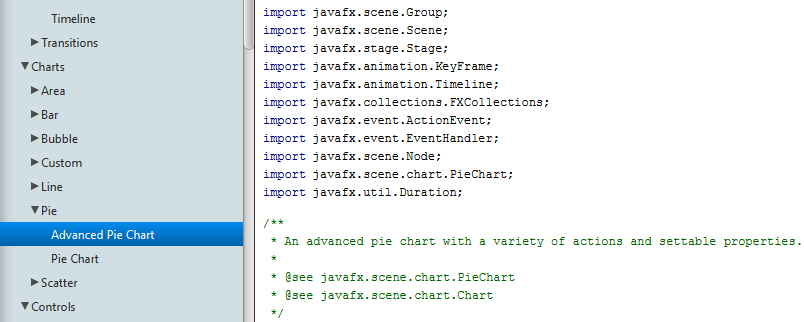FX Experience Has Gone Read-Only
I've been maintaining FX Experience for a really long time now, and I love hearing from people who enjoy my weekly links roundup. One thing I've noticed recently is that maintaining two sites (FX Experience and JonathanGiles.net) takes more time than ideal, and splits the audience up. Therefore, FX Experience will become read-only for new blog posts, but weekly posts will continue to be published on JonathanGiles.net. If you follow @FXExperience on Twitter, I suggest you also follow @JonathanGiles. This is not the end - just a consolidation of my online presence to make my life a little easier!
tl;dr: Follow me on Twitter and check for the latest news on JonathanGiles.net.
by Jonathan Giles | Feb 15, 2012 | News
I’m very pleased to blog about the availability of more JavaFX source code being out in the wild. We’ve just put out the ‘javafx-ui-common’ project, which contains the vast majority of the JavaFX scenegraph API. You can check the code out from OpenJFX – it is in the rt repository. You can learn more about the javafx-ui-common project in a post by Richard Bair.
The javafx-ui-common project contains the following packages:
javafx.animation
javafx.application
javafx.geometry
javafx.scene
javafx.scene.effect
javafx.scene.image
javafx.scene.input
javafx.scene.layout
javafx.scene.paint
javafx.scene.shape
javafx.scene.text
javafx.scene.transform
javafx.stage
Once you’ve read that be sure to go and check it out! 🙂
by Jonathan Giles | Feb 12, 2012 | Links
Welcome to another weeks worth of interesting JavaFX links. I hope you enjoy! 🙂
- Another week brings another developer preview release of JavaFX 2.1, this week taking the build number up to b12.
- Brian Burkhalter, a member of the JavaFX media team, has blogged about the upcoming MPEG-4 multimedia support in JavaFX 2.1.
- Michael Heinrichs has put up another useful post, this week detailing when to use a ChangeListener, and when to use an InvalidationListener in JavaFX. This is very useful to know as there can be major performance repercussions if you don’t understand the difference.
- Dustin Marx continues his posts on JavaFX, this week detailing path transitions in the JavaFX 2.x animation APIs.
- It seems playing with TextField is popular now. Following on from Richards blogs mentioned last week, Thomas Bolz has blogged about has blogged about creating both a JavaFX NumberTextField, and a Spinner control. Dierk König has done a simliar thing, except he shows how he did it using GroovyFX.
- In another post by Dierk, he covers the basics about UI construction with JavaFX.
- The slides and code from Weiqi Gao’s talk at the St. Louis Java Users Group is now available online.
Catch you all next week!
by Jonathan Giles | Feb 6, 2012 | Links
Sorry for the delayed post this week, I’ve been a little bogged down in other work recently. But anywho, here we go for another week – enjoy! 🙂
JavaFX
Swing
That’s all for another week. Catch you again in a weeks time.

by Jonathan Giles | Jan 30, 2012 | News, Tips n' Tricks

Phil Race has posted a blog post over at the JavaFX Blog on the addition of LCD text support in the latest JavaFX 2.1 developer preview.
LCD sub-pixel text has become a must-have for many Windows desktop users, who have become accustomed to its superior legibility and less blocky appearance at smaller point sizes over hinted black and white text, and being sharper than grey scale anti-aliased text at the same size.
Java SE has supported LCD subpixel text on AWT heavyweights and also on Swing components using Java 2D for many years. However up until now, JavaFX has supported only more Mac OS X-like grey scale smoothed text.
For the JavaFX 2.1 release we’ve added the ability to use Windows-style LCD sub-pixel rendering. All the JavaFX UI controls will be LCD-text enabled by default on Windows, as will “WebView”, the Webkit-based node for rendering Web content.
Applications can also opt-in to use LCD text on the low-level scenegraph “Text” node by a new API : Text.setFontSmoothingType(FontSmoothingType.LCD));
by Jonathan Giles | Jan 29, 2012 | Links
These intros become harder as the weeks go by. The core message is always the same: Enoy! 🙂
JavaFX
- It’s another week, so another developer preview release of JavaFX 2.1 is out for Linux, Mac OS and Windows. This week we are up to build 10.
- With the availability of JavaFX 2.1 developer preview builds for Linux, a number of people and news websites covered this. For example: Weigi Gao, Jaxenter, and H online.
- Jasper Potts has put up two blogs posts here at FX Experience. The first post discusses his work on extending the PathBuilder class to include more convenience methods, and secondly he has a post about extending the charts code shipped with JavaFX to apply curve fitting.
- Speaking of the builder classes shipped with JavaFX, Michael Heinrichs, a member of the JavaFX team, has put up a post about the advantages of the JavaFX builder APIs.
- Kevin Farnham put up a blog post over at Java.net about getting started with the JavaFX 2.1 developer preview on Linux.
- Dustin Marx talks about the @DefaultProperty annotation used in the JavaFX APIs, and what this means for you when building user interfaces with FXML.
- The GroovyFX library now has a new website.
- Thierry Janaudy has a blog post showing how to put a pie chart inside a TableView using a custom cell factory, whilst programming in Scala.
- Sébastien Bordes has a post detailing how to build and package JavaFX application with Maven.
- Narayan has blogged about the ‘include’ and ‘define’ tags in FXML.
- Yet another DatePicker control has appeared, pushing my count to at least five such controls. This week it belongs to Altuğ Uzunali.
- Andrew Krizhanovsky let me know about his wikokit project, which he describes as a “Machine-readable Wiktionary with GUI now ported to JavaFX 2.0. This version contains huge drop-down list of available languages.”
These conclusions are equally difficult. The core message is always the same: I hope you enjoy what I just linked to, and I hope it was good enough to see you again in a weeks time (where hopefully my introductions and conclusions are slightly more considered!) 🙂



